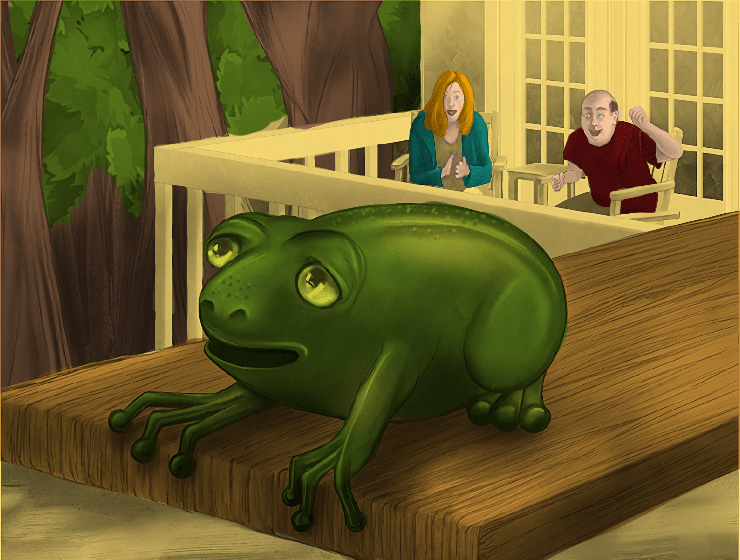Read by Matilda Longbottom

The neighbor’s cat was on our deck railing, and it was obvious from the way he stood—crouched, head bent, still—that he was up to no good. I slid open the patio door and stepped outside to check. There, directly under his nose, was a plump, gray-and-brown tree frog. The small frog sat frozen, motionless except for the slight puffing at his throat.
I shooed the cat away. But then, instead of going back inside, I settled into a deck chair to see what would happen next. I’m glad I did. When the frightened frog finally moved, I saw an amazing sight. Stretching his long back legs behind him, he jumped and landed at the exact corner of our railing, the point closest to a grove of trees that line our yard. He paused—to gauge the distance?—and then leapt. He flew three feet in the air, caught the closest birch branch with his front legs, and, after swinging precariously up and down a few times, began to climb. He continued climbing until he was even with a cedar bough. Another leap and his gray-brown legs were splayed in an X on the deep green bough. He inched his way slowly upwards until he found another sturdy limb. From there, he wove along the pathway of branches into the dark heart of the cedar grove—and disappeared.
I exhaled. I’d been holding my breath the whole time.
I was just about to get up when I noticed another frog, this one bright green with an iridescent bronze stripe down its back, climbing out of one of the many flowerpots in the corner of my deck.
This tiny frog was no bigger than my thumb. He jumped from the edge of the pot to a railing upright and started climbing. Soon he was at the exact spot where the cat and frog had been. He moved to the corner of the deck railing, paused, and leapt. His path into the cedars was almost identical to the one taken by the first frog.
The sun began going down—and three more frogs emerged from the pots. One by one they moved to the jump-off spot, paused a moment, and leapt. I gave a mental cheer each time.
The migration from deck to tree continued until the sun set, with 19 frogs completing the journey. Ranging in size from small as a fingernail to over three inches, they displayed the colors of their potted homes—dirt brown, light green, luminous copper, speckled blue, clay red.
The next night, my husband joined me on the deck. For several nights, we enjoyed the reoccurring show. The number of frogs varied, but the routine didn’t—exit a pot, climb the upright, get to the railing, march to the corner, pause, take a death-defying leap, crawl up the branches, and disappear into the trees.
But then disaster struck. Landscapers we had hired to help tame our overgrown yard got a bit carried away with their pruning efforts. They cut back the lower branches of the cedars and birch, essentially demolishing the frogs’ landing pad.
That evening, we watched anxiously when the first frog made his trip to the corner. He paused longer than usual, gauging the distance from the railing to the tree—now almost seven feet! Sensing that something had changed, he abruptly turned, made his way back along the railing, and began a laborious descent down the deck. He then trudged across the lawn to the base of the tree, up its trunk—and finally into the dark center of the cedars.
We were dismayed. Traveling across the lawn left the frogs exposed to neighborhood cats and the birds at our feeders. We had to do something!
The following weekend we tried building a small ramp off the corner of the deck railing. Since we live in Seattle, the bridge had to be waterproof. Plastic looked hideous. Cardboard was out of the question. Finally, we settled on a four-foot wooden plank. We attached it with a C-clamp and crossed our fingers.
That evening we watched closely when the first frog emerged from the pots. Just as we suspected, he started heading down to the lawn. It was time to intervene—to make him “walk the plank.” I placed my hands in front of him and tried to guide him towards the plank. He jumped and landed on my shirt! I pried him from my collar and tried again. And again. And again. Finally, he took hesitant steps along the railing, but stopped short of the plank. I gave him a small nudge and he reluctantly moved onto the ramp. At the end of the plank, he halted, did a new jump-distance calculation, and leapt. Success! He caught a cedar bough, swayed a bit from the force of the jump, and began to climb into the shadows. We were elated. Our plan had worked!
It took some time for the rest of the frogs to figure out the new routine. But after about a week, the March of the Frogs was back on track. We enjoyed the show during the last mellow evenings of late Summer and early Fall. But it ended (as we knew it would) in late Autumn when days grow short and deck pots house neither frogs nor flowers. As I stored the well-used plank and pots for Winter, I smiled in anticipation.
Of next Summer. ❖
This article was published originally in 2016, in GreenPrints Issue #106.



